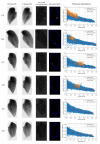Unsupervised Foreign Object Detection Based on Dual-Energy Absorptiometry in the Food Industry
- PMID: 39080892
- PMCID: PMC8321356
- DOI: 10.3390/jimaging7070104
Unsupervised Foreign Object Detection Based on Dual-Energy Absorptiometry in the Food Industry
Abstract
X-ray imaging is a widely used technique for non-destructive inspection of agricultural food products. One application of X-ray imaging is the autonomous, in-line detection of foreign objects in food samples. Examples of such inclusions are bone fragments in meat products, plastic and metal debris in fish, and fruit infestations. This article presents a processing methodology for unsupervised foreign object detection based on dual-energy X-ray absorptiometry (DEXA). A novel thickness correction model is introduced as a pre-processing technique for DEXA data. The aim of the model is to homogenize regions in the image that belong to the food product and to enhance contrast where the foreign object is present. In this way, the segmentation of the foreign object is more robust to noise and lack of contrast. The proposed methodology was applied to a dataset of 488 samples of meat products acquired from a conveyor belt. Approximately 60% of the samples contain foreign objects of different types and sizes, while the rest of the samples are void of foreign objects. The results show that samples without foreign objects are correctly identified in 97% of cases and that the overall accuracy of foreign object detection reaches 95%.
Keywords: X-ray; absorptiometry; dual-energy; foreign object detection.
Conflict of interest statement
The authors declare no conflict of interest.
Figures









References
-
- Kwon J.S., Lee J.M., Kim W.Y. Real-time detection of foreign objects using X-ray imaging for dry food manufacturing line; Proceedings of the 2008 IEEE International Symposium on Consumer Electronics; Vilamoura, Portugal. 14–16 April 2008; pp. 1–4.
-
- van Dael M., Lebotsa S., Herremans E., Verboven P., Sijbers J., Opara U., Cronje P., Nicolaï B. A segmentation and classification algorithm for online detection of internal disorders in citrus using X-ray radiographs. Postharvest Biol. Technol. 2016;112:205–214. doi: 10.1016/j.postharvbio.2015.09.020. - DOI
-
- Chuang C.L., Ouyang C.S., Lin T.T., Yang M.M., Yang E.C., Huang T.W., Kuei C.F., Luke A., Jiang J.A. Automatic X-ray quarantine scanner and pest infestation detector for agricultural products. Comput. Electron. Agric. 2011;77:41–59. doi: 10.1016/j.compag.2011.03.007. - DOI
Grants and funding
LinkOut - more resources
Full Text Sources

